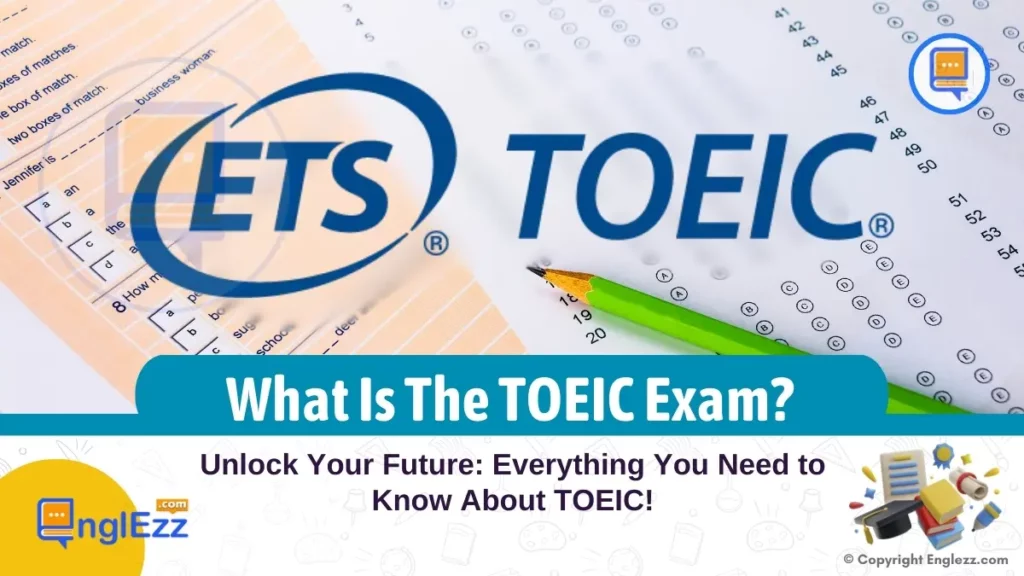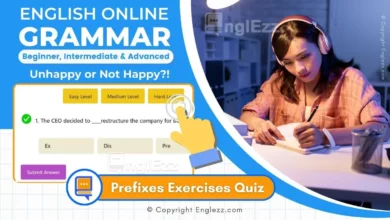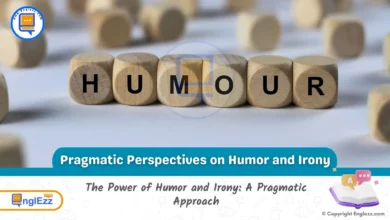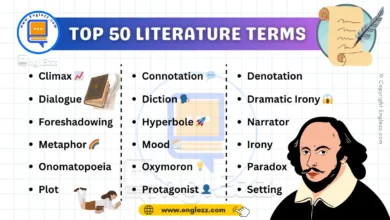In today’s increasingly interconnected world, effective communication skills across borders and cultures have become more crucial than ever. For those seeking to demonstrate their English language proficiency for international communication purposes, the TOEIC (Test of English for International Communication) exam has emerged as a widely recognized benchmark.
Whether you’re a professional aiming to enhance your career prospects or a student dreaming of studying abroad, the TOEIC exam can open doors to exciting opportunities by providing an objective measure of your language abilities.
Table of Contents
- What Is the TOEIC Exam? All You Need to Know
- The importance of taking the TOEIC exam
- The Test of English for International Communication (TOEIC) Overview
- Origins:
- Structure & Format
- TOEIC Question Types:
- TOEIC Scoring System – Scaled Scores & Levels
- Comparison with Other Exams (e.g., IELTS or TOEFL)
- TOEIC Significance & Recognition
- TOEIC Preparation Tips & Resources
- Importance and Value of the TOEIC Exam in Today’s Interconnected World
- Wrapping Up
- Frequently Asked Questions About TOEIC Exam
What Is the TOEIC Exam? All You Need to Know
At its core, the TOEIC exam is designed to assess an individual’s ability to use English in real-life workplace scenarios. Developed and administered by ETS (Educational Testing Service), this internationally renowned test evaluates various aspects of language proficiency including listening and reading comprehension. Through authentic questions and diverse content from business contexts worldwide, it reflects the demands faced by individuals navigating global work environments.

Embark with us on an enlightening exploration into all facets of this esteemed examination – from its origins and structure to its significance in our rapidly evolving world. Gain unparalleled insights that will empower you on your path toward achieving linguistic excellence while setting yourself up for success on both local and international stages. Uncover why millions worldwide have chosen the TOEIC as their trusted ally on their quest for effective cross-cultural communication – because fluency knows no boundaries!
The importance of taking the TOEIC exam
The importance of taking the TOEIC exam cannot be overstated given its widespread recognition by employers and educational institutions alike. An impressive performance on this test demonstrates not only your command over English but also your adaptability in multicultural settings – a valuable asset in today’s globally connected economy.
So whether you aspire for better job opportunities or wish to gain admission into top-notch universities or simply desire personal growth through linguistic mastery, embarking on the journey towards conquering the TOEIC exam is undoubtedly a step in the right direction.
The Test of English for International Communication (TOEIC) Overview
The Test of English for International Communication (TOEIC) is a standardized English proficiency test designed for professionals and companies. It assesses language skills used in daily life and the workplace.
Key Features:
- Two separate tests: Receptive English skills (reading and listening) and Productive English skills (speaking and writing)
- Duration: 120 minutes for the receptive test and 80 minutes for the productive test
- Result report: Available within 3 to 15 days
- Test location: Authorized test centers worldwide
- Score validity: 2 years
Test Format:
- Listening and Reading Test: 200 questions, 2 hours, optically-scanned answer sheet
- Listening (approximately 45 minutes, 100 questions)
- Reading (75 minutes, 100 questions)
- Speaking and Writing Test: Optional, available in some countries
Purpose:
- Used by organizations to determine employee suitability for specific tasks
- Useful for those working or seeking to work for large organizations, particularly in Asia
Cost: Fees vary by test center, approximately $140 USD per component (Listening and Reading/Speaking and Writing)
Registration: Contact local EPN offices or authorized test centers for registration and evaluation of English communication skills.
Origins:
History:
The Test of English for International Communication, or TOEIC, has a rich history that dates back to the early 20th century. The exam was initially developed in Japan in 1979 by the Institute for International Business Communication (IIBC) as a way to evaluate the English language skills of Japanese employees working in international companies. Over time, it gained recognition beyond Japan and evolved into one of the most widely taken English proficiency tests worldwide.
ETS (Educational Testing Service):
The administration and development of TOEIC are currently managed by ETS, an organization renowned for its expertise in educational assessment. ETS is responsible for designing and refining the exam content, setting standards for scoring and reporting results, as well as ensuring global consistency and reliability.
As a non-profit organization based in the United States, ETS plays a vital role in maintaining the integrity and quality of TOEIC across various countries and cultures. Through its extensive network of authorized test centers around the world, ETS enables individuals from diverse backgrounds to access this internationally recognized means of assessing their English communication skills accurately.
Structure & Format
Sections:
The TOEIC exam is divided into two main sections—Listening Comprehension and Reading Comprehension. In the Listening Comprehension section, test-takers are required to listen to a series of audio clips and answer questions based on them. These audio clips include conversations, talks, and announcements typically encountered in everyday communication situations. This section evaluates an individual’s ability to understand spoken English across different accents and speeds.

On the other hand, the Reading Comprehension section assesses a person’s understanding of written English texts such as emails, articles, advertisements, and charts. Test-takers must read these materials carefully and respond to questions that gauge their comprehension skills. This section particularly focuses on assessing one’s ability to grasp key information, infer meaning from context, make logical deductions, analyze data presented in graphs or charts—all crucial skills for effective international communication.
TOEIC Question Types:
Each section consists of various question types that measure different aspects of language proficiency. In the Listening Comprehension section, common question formats include multiple-choice questions where test-takers choose the correct response based on what they hear; short-answer questions where responses can be as brief as one word or a short phrase; and completion tasks where individuals fill in missing words or phrases from transcripts.
One crucial aspect of acing the TOEIC exam is effective time management during the test. Make sure to allocate enough time for each section and question, and practice under timed conditions to improve your speed and accuracy.
Similarly, the Reading Comprehension section incorporates several question types including multiple-choice questions with single or multiple answers; sentence completion tasks where participants fill in gaps with appropriate words or phrases; text completion exercises requiring selection from given options to complete sentences or paragraphs accurately; matching tasks that involve linking headings with relevant paragraphs or descriptions; true/false statements verification pertaining to specific details mentioned in texts.
Understanding the structure of each section along with familiarizing oneself with these various question types enables candidates to develop effective strategies for tackling each item effectively while managing time efficiently during the TOEIC exam.
TOEIC Scoring System – Scaled Scores & Levels
The scoring system of the TOEIC exam is based on a scaled score, which allows for a standardized evaluation of test takers’ English language proficiency. The TOEIC score range spans from 10 to 990 points, with each section (Listening and Reading) being separately scored out of 495 points. A higher score indicates a higher level of proficiency in English.
To provide clear benchmarks for employers and institutions, the scaled scores are categorized into different levels according to the Common European Framework of Reference for Languages (CEFR). These levels range from A1 (beginner) to C1+ (advanced), allowing individuals to gauge their language abilities in relation to global standards. This enables employers and organizations to assess candidates’ suitability for job positions or academic programs that require specific language skills.
Comparison with Other Exams (e.g., IELTS or TOEFL)
While exams such as IELTS (International English Language Testing System) and TOEFL (Test of English as a Foreign Language) also evaluate English language proficiency, they employ different grading systems compared to the TOEIC exam.
IELTS uses an overall band scale ranging from 1-9, categorizing test takers into four main bands: Band 1 representing non-user competence, while Band 9 reflects expert-level fluency. While both tests aim at assessing similar language skills—reading, writing, listening, and speaking—the scoring methods differ significantly.
On the other hand, TOEFL’s grading system comprises scores between 0-120 points. Each section receives separate scores out of this total with additional essay grades in some cases. Similarities can be drawn through content assessment areas like reading comprehension; however distinct approaches are taken towards aspects such as evaluating spoken expression or vocabulary usage.
Understanding these comparisons helps individuals identify which examination best aligns with their goals while avoiding any misconceptions about how scores are interpreted across different exams. Granting clarity on these distinctions allows test takers to make informed decisions and better prepare for their chosen English language proficiency assessment.
TOEIC Significance & Recognition
Global Acceptance:
One of the key reasons why the TOEIC exam has gained immense popularity over the years is its global acceptance. This standardized test is recognized by thousands of organizations, educational institutions, and employers worldwide as a reliable measure of an individual’s English language proficiency. Whether you plan to study abroad, join multinational companies, or immigrate to an English-speaking country, having a good TOEIC score can open doors for you in various professional fields.
Employment Opportunities:
In today’s increasingly interconnected world, employers are seeking candidates who possess strong communication skills and can effectively navigate cross-cultural environments. A high TOEIC score can greatly enhance your career prospects globally. Employers recognize that individuals with advanced English language skills are better equipped to interact with stakeholders from different countries and contribute positively to international business operations.
Identify your weaker areas in English language skills such as grammar, vocabulary, listening comprehension, or reading comprehension. Devote extra time to improve these areas through targeted practice and study methods to boost your overall performance on the exam.
In fact, many global corporations require job applicants to submit their TOEIC scores as part of their application process. By achieving a competitive TOEIC score, you not only increase your chances of securing desirable employment opportunities but also demonstrate your commitment towards professional growth in an ever-expanding global marketplace.
TOEIC Preparation Tips & Resources
Study Materials:
When preparing for the TOEIC exam, it is essential to have reliable study materials at your disposal. Start by obtaining a comprehensive TOEIC test preparation book that includes practice tests, sample questions, and detailed explanations of each section. Some popular options include The Official Guide to the TOEIC Test published by ETS (Educational Testing Service), which provides an in-depth understanding of the exam format and content.
In addition to books, there are several online resources that can aid in your TOEIC preparation journey. Websites such as ETS’s official TOEIC website offer free practice exercises and sample questions. There are also numerous online platforms where you can find additional practice tests specifically designed for the different sections of the exam.
Preparing Strategically:
To optimize your performance on the TOEIC exam, it is crucial to develop effective strategies during your preparation period. Familiarize yourself with each section’s format and time constraints so that you can allocate your time wisely during the actual test.
For example, in the Listening section, practice active listening skills by focusing on keywords and main ideas while taking notes. Additionally, make use of transition words or highlighting key information when answering Reading section questions effectively.
On the day of the TOEIC exam, remember to stay calm and confident in your abilities. Anxiety can hinder your performance, so practice relaxation techniques beforehand to keep a clear mind during the test and tackle each question with focus and determination.
It is also beneficial to engage in intensive reading activities as part of your overall English language proficiency improvement strategy. Read a variety of materials such as news articles, business magazines/ journals or academic papers written in English related to topics covered on the TOEIC exam.
By adopting these strategic approaches and utilizing high-quality study materials consistently over time; you will be well-prepared both mentally and linguistically for success on test day!
Importance and Value of the TOEIC Exam in Today’s Interconnected World
English has become the lingua franca of our globalized society, with millions of people around the world using it as a means of communication in various professional settings. As businesses continue to expand across borders, employers are increasingly seeking candidates who possess strong English language skills for effective international communication. The TOEIC exam serves as a valuable tool for individuals looking to showcase their abilities in this regard.
One essential tip to excel in the TOEIC exam is to practice effective time management. The test consists of various sections with strict time limits, so it’s crucial to allocate your time wisely during the exam. By practicing with timed exercises and honing your ability to work efficiently under pressure, you can maximize your performance on test day.
One of the key benefits of taking the TOEIC exam is that it provides a standardized assessment that is recognized and respected by companies, organizations, and institutions worldwide. It offers an objective measure of one’s English proficiency level, making it easier for employers to evaluate job applicants or educational institutions to assess prospective students.
By including scores from both listening and reading sections, the test accurately reflects an individual’s ability to understand spoken conversations and written materials—an essential skill when working or studying in an English-speaking environment.
Moreover, obtaining a high score on the TOEIC exam can open doors to various opportunities. Many multinational corporations use TOEIC scores as part of their hiring criteria for positions requiring international interactions or dealing with clients from different countries. Additionally, universities may require certain minimum scores on the TOEIC exam for admission into degree programs taught solely or partially in English. Thus, achieving good results on this test can enhance career prospects and academic aspirations alike.
Another key tip for success in the TOEIC exam is to focus on improving your listening and reading skills. These two sections carry significant weight in determining your overall score, so dedicating ample time to enhancing your comprehension abilities can greatly impact your results. Engage with English-language materials such as podcasts, articles, and videos to sharpen these crucial skills.
In short, understanding the importance and value of the TOEIC exam is vital for anyone aiming to excel professionally or academically in today’s interconnected world. Its consistent evaluation standards provide individuals with a reliable measure of their English language skills that is widely recognized globally. By showcasing proficiency through this examination, individuals can position themselves favorably in competitive job markets while also gaining access to higher education opportunities where fluency in English plays a crucial role.
Wrapping Up
In conclusion, the TOEIC exam serves as a valuable tool for assessing individuals’ English language proficiency in a global context. By measuring listening and reading skills specifically in a business environment, the test provides employers with a reliable indicator of an individual’s ability to communicate effectively in various professional settings. Furthermore, achieving a high score on the TOEIC exam can open up new career opportunities and enhance one’s overall employability.
However, it is important to remember that standardized tests like the TOEIC are just one aspect of evaluating language proficiency. Practical communication skills, cultural understanding, and real-world experience also play crucial roles in determining an individual’s true language abilities. Therefore, while preparing for the TOEIC exam is beneficial, it should be viewed as part of a larger journey towards becoming a confident and proficient English speaker in diverse real-life situations.
Lastly, consider taking regular mock tests as part of your preparation strategy for the TOEIC exam. Mock tests not only help you familiarize yourself with the format and structure of the exam but also enable you to identify areas where you may need further improvement. Use these practice tests as a tool for evaluating your progress and refining your test-taking strategies before the actual exam day arrives.
Frequently Asked Questions About TOEIC Exam
Q: How is the TOEIC exam structured and what does it involve?
A: The TOEIC exam consists of two sections – listening and reading. The listening section evaluates proficiency in understanding spoken English through various audio clips, while the reading section tests comprehension of written English passages. Both sections include multiple-choice questions designed to gauge language skills in a business context.
Q: What is the purpose of taking the TOEIC exam?
A: One major reason for taking the TOEIC exam is to showcase proficiency in English for professional opportunities. Many companies and organizations use TOEIC scores as a standardized measure of employees’ language capabilities, especially in roles that require communication with international clients or partners. Additionally, obtaining a high score on the TOEIC exam can enhance career prospects and open doors to global job markets.









What Is the TOEIC Exam? Uncover vital information, preparation tips, and benefits of this crucial English assessment for your professional journey!